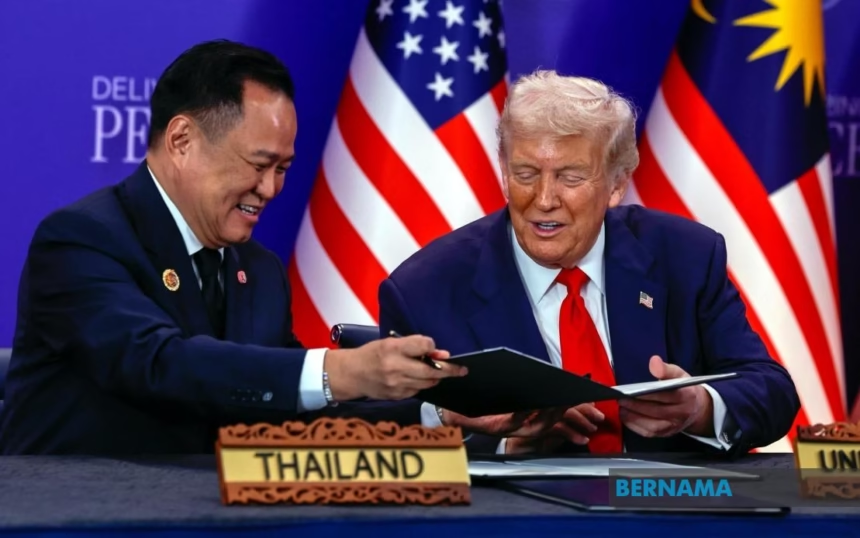KUALA LUMPUR — On the sidelines of the 47th ASEAN Summit, the United States and Thailand announced a reciprocal trade framework on Sunday, 26 October 2025. The plan aims to tear down long-standing tariff barriers and lift two-way trade.
Built around President Donald Trump’s push for what he calls fair and balanced deals in Southeast Asia, the arrangement holds a 19% US tariff on Thai goods while opening Thailand’s $500 billion market to American exporters with few restrictions. It marks a strategic shift, strengthening supply chains against Chinese influence and injecting fresh energy into a partnership rooted in the 1966 Treaty of Amity.
The framework caps months of difficult talks triggered by Trump’s April Executive Order 14257, which warned of 36% tariffs on partners deemed non-compliant, citing a $1 trillion US trade deficit.
Thailand, the 13th-largest US trading partner with about $80 billion in annual trade, avoided that higher rate in August with a provisional 19% level, yet still faced pressure over border clashes with Cambodia. Trump’s mediation of the Kuala Lumpur Peace Accords earlier in the day, which secured a ceasefire and the release of 18 Cambodian detainees, cleared the way for a broader deal.
“This is the art of the deal in practice,” Trump said at the signing with Thai Prime Minister Anutin Charnvirakul, joined by Malaysian and Cambodian leaders. “Thailand is opening up to American innovation, from aircraft and beef to technology, and we are keeping it reciprocal. No more free rides.”
White House touts ‘unprecedented market access’
A joint White House statement, released late Saturday, casts the framework as a core element of Trump’s Indo-Pacific strategy. “The United States and the Kingdom of Thailand have agreed to a Framework for an Agreement on Reciprocal Trade to strengthen our bilateral economic relationship, which will provide both countries’ exporters unprecedented access to each other’s markets,” it said.
Thailand will phase out tariffs on 99% of US goods, including industrial machinery, soybeans, and pork, speed up approvals for U.S. Food Safety and Inspection Service-certified meat, and ease non-tariff barriers such as vehicle standards.
In exchange, the US will maintain its reciprocal tariff at 19% under Executive Order 14257, while offering zero-tariff incentives for select Thai products listed in Annex III of September’s Executive Order 14346. Electronics and auto parts, Thailand’s export standouts, are among the potential beneficiaries. The framework also addresses digital trade, pledging no discriminatory taxes on US tech firms, and deepens cooperation on export controls to fight duty evasion.
US Trade Representative Katherine Tai called the deal a win for farmers and manufacturers, highlighting Thailand’s commitments on illegal fishing and wildlife trade as part of wider environmental aims. Both sides aim to conclude a full agreement by year-end, expanding to services, investment, and detailed rules of origin to prevent transshipment.
The pact carries a wider strategic weight. Trump signed parallel arrangements with Malaysia and Cambodia, maintaining their tariffs at 19% while securing commitments on critical minerals to reduce reliance on China’s rare earths. A separate US–Thailand minerals initiative targets joint ventures in lithium and cobalt, key inputs for electric vehicles and clean energy.
Thailand’s economy set for a lift as exports climb
For Thailand, the deal offers support in a difficult year. The export-heavy economy grew 2.5% in 2024 amid a global slowdown and a volatile baht. The US takes around 18% of Thailand’s roughly $280 billion in annual exports, from Seagate hard drives to rubber for Goodyear tyres. Locking in a 19% US tariff rate is seen as positive after the close call with a possible 36% rate in August.
Finance Minister Pichai Chunhavajira praised the framework as a boost to competitiveness. He said it strengthens Thailand’s position, improves investor sentiment, and supports growth, higher incomes, and jobs. Earlier forecasts pointed to 2025 GDP growth of 2.2% under a 19% tariff scenario, compared with 2.1% if rates rose to 36%.
Commerce Minister Suphajee Suthasilakul said the deal fast-tracks talks on sensitive areas, keeping protections on rice and sugar while opening the door wider to US medical devices and chemicals.
Kasikorn Research Center expects Thai exports to the US to rise about 1.5% over two years, adding 0.3 percentage points to GDP. That matters as tourism recovers after floods and manufacturers diversify from China under China Plus One strategies. Boeing could be a major winner, with Thailand committing to buy 80 US aircraft worth $18.8 billion, a boost for American aerospace as it competes with Airbus.
There are trade-offs. Thai farmers worry about cheaper US corn and poultry undercutting local producers, despite safeguards. Labour unions warn that quicker US vehicle imports could threaten jobs in Thailand’s auto clusters.
While the agreement strengthens supply-chain security and targets unfair third-country practices, Bangkok must manage domestic politics. Prime Minister Anutin’s coalition, already strained after July’s border flare-up, faces resistance from agricultural protectionists.
Wider effects across Southeast Asia’s trade map
The framework fits into Trump’s ASEAN push, which yielded six deals in one day, from tariff talks with Vietnam to streamlined halal certification with Malaysia. It acts as a counterweight to Beijing’s Belt and Road, with a focus on friendshoring for semiconductors and EVs. For Thailand, it reinforces its central role within ASEAN and could set up future US–Japan–Thailand collaborations.
Skeptics, including some Thai exporters, warn about leaning too heavily on Washington, given Trump’s unpredictability. A Bangkok chamber official said the new rules of origin could snare goods routed through Vietnam, swapping one risk for another. Even so, with the baht near 33 to the dollar and foreign direct investment up about 10% year to date, sentiment remains positive.
As talks move toward a December finish, the pact highlights a clear theme from Trump’s trade fights. In a divided global market, reciprocity has become the currency of trade. For Thailand, the bet is that deeper ties with the US will power its next phase of growth.














